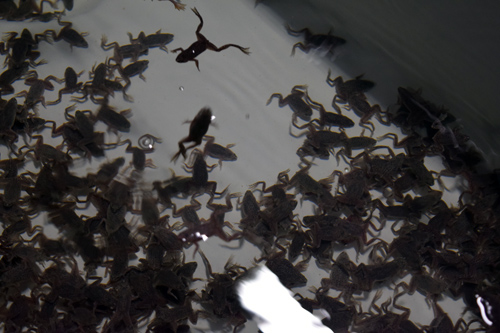
Editor’s Note: Editor Donald H. Harrison and his grandson Shor recently completed a 2,000 mile journey through California and Nevada, collecting and photographing Jewish stories along the way. This article is the second in a series generated during that trip.
Story by Donald H. Harrison; photos by Shor M. Masori


MADERA, California – Stuart Weil raises enough frogs to plague Pharaoh.
“Actually, we are looking for that contract,” he quips. “If ever they bring back those plagues, we want the contract. He (God) buys in great numbers and has great credit!”
In the meantime, Weil’s customers are pet stores catering to people who wish to keep in their aquariums the small creatures that at full growth measure less than three inches. From his farm in this San Joaquin Valley city, where he also grows mandarin oranges, Weil ships his frogs in special oxygenated containers to destinations throughout the United States.
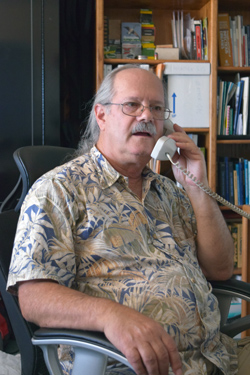
The frogs are raised in 4 by 10 feet tanks that are slightly tilted to permit water to flow through them by gravity. Life starts for the future pets in a tank in which breeder frogs lay their eggs. The eggs are collected and moved to a fresh, new sterilized tank, “and those eggs take three or four days to hatch out,” Weil said. On the fifth day, they typically become free swimming tadpoles, and “on the sixth day we start feeding them. They will stay in there for the next month and a half or so, and at that point, we transfer them to another clean tank. We try to keep everything really clean, and every two months or so we try to move the frogs to a new system, and sterilize the tanks.”
“Sterilization” and “cleanliness” have become bywords at the Blue Lobster Farms which back in 2011 was reported by the Center for Disease Control as the source of a non-fatal salmonella outbreak affecting 241 persons nationwide. In an advisory to aquarium owners, the CDC said people should wash their hands thoroughly after touching the African Dwarf Frogs, or the water they have swum in, or any of the equipment they have touched. Water from the aquariums should not be dumped in household sinks, the CDC went on to advise.
Asked about that episode, Weil responded: “I was contacted by the CDC in Atlanta about salmonella and agreed to their request to visit my facility in Madera. They arrived with about 12 people from their office as well as health officials from across the country. Over 30 county, state and federal officials were present that day taking samples and asking questions to me and my employees.
“To make a long story short, I voluntarily agreed to stop all shipments of frogs until salmonella was eradicated from my farm. It took months for me and my employees to develop protocols to stop the transmission of the disease from the brood stock to the tadpole. Because there is little research on the transmission of the disease in frogs, the government agencies only monitored my progress giving little usable advice. Through this process, I blew through a couple hundred thousand dollars of savings because I decided to keep all of my employees.
“Thank G-d no one died because of my frogs nor was there a single lawsuit filed against me. The good news about this ordeal is I helped develop guidelines and protocols for the pet industry that are used throughout the country.”
Walking around the tanks, visitors can see the three stages of the animal’s life cycle: egg, tadpole, and frog. The entire process of egg to frog takes about two months, according to Weil. The frogs typically will live for five years, but there have been instances of African Dwarf Frogs living for as long as 20 years.
“A tadpole has a tail and gills,” Weil instructs. “It gets its oxygen from the water. These guys (the frogs) have lungs. They come up and breathe air.”
How many tanks do you have? I asked Weil.
He surveyed the 16,000 square foot indoor breeding farm and began to count the tanks by configurations. “8-8-8-8-4-8-8-8-8-4-4,” he said. Adding these numbers up, I came up with a total of 76 tanks.
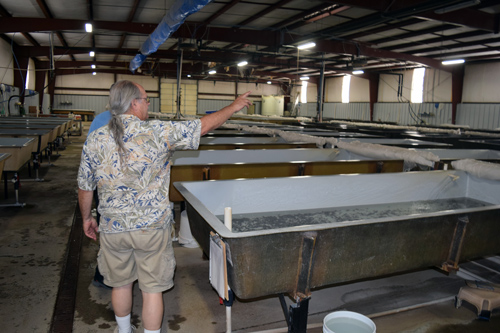
So how many frogs does he have?
“I don’t know,” he responded, noting that the number changes daily as eggs hatch and older frogs are shipped out. “The workers count them.” Whatever the exact number may be, the total is within the many thousands.
Water heated to approximately 78 degrees is an important component of the frog raising business, Weil says. “Temperature can be used to either increase or decrease the birth rate,” he added. “There are a lot of things that you can do with temperature, so we have the ability to change it. Sometimes, if we have some big orders coming up in a few weeks, we put up the temperature, put in more food, and the birth rate will go up. Warmer water, more food, and away we go. We have these hydronic lines that go through the building. Each on has a thermostat, tells the computer what temperature it is, and if needs heat, it will add more hot water.”
Weil has a co-generation system to supply both heat and electricity. One important component of the system is solar heating. There is also a boiler as well as other heating sources that enable Weil to reduce what otherwise would be a far more sizable energy bill.
The fish-based food fed to his frogs is supplied to Weil’s Blue Lobster Farms by a company in Utah. The frogs “need a high protein food,” he commented. “In the wild, they will eat larvae of fish, larvae of insects or the insects themselves.”
Before he switched to raising frogs for pet stores, Weil raised freshwater shrimp for consumption. “The first few years we raised them pond side, no processing, just live shrimp on ice, and we would get $8.50 a pound. The last year that we harvested them we got $3 a pound. The aquaculture industry around the country had started to develop. I couldn’t beat them, so I quit the food business.”
He began selling baby shrimp to the aquarium industry, and “we learned what was needed was frogs and so we started raising them. We made the transition (during the 1980s). As shrimp got lower, the frog part of our business expanded, until we got rid of the shrimp. We had other species as well such as ornamental catfish from South America.”
An active member of the Republican Jewish Coalition and a supporter of Chabad, Weil travels often to Israel, both for business reasons – Israel has a thriving aquaculture industry – and family reasons. One of his two daughters lives in Jerusalem; the other lives in Tel Aviv, where she is a dancer in the ballet.
Weil is also active on the Fresno County Republican Central Committee, and has been a supporter and friend to Republican Congressman Devin Nunes, who heads the House Intelligence Committee.
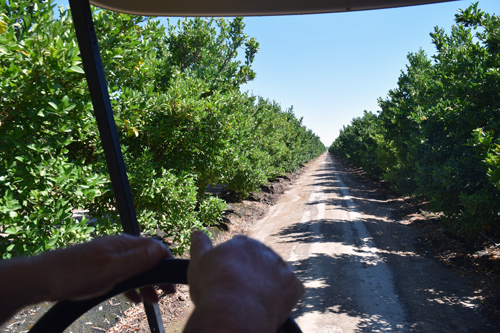
He said he planted his mandarin orange groves in 2006 in order to provide work for his employees at times when the fish farm did not require their attention. “You can’t just hire part-time people; you have to give them work all day long,” he said. “We decided to put some trees in to tend when they are not in the hatchery.” Generally, the mandarin oranges are harvested in the first three months of the year.
Weil said rather than dealing with just one packing house, he deals with several so that he can negotiate prices without being at a single packing house’s mercy. The moral of his experience is don’t put all your mandarin oranges in one basket.
Unlike the sons of many multi-generational agricultural families in Fresno, Weil is the first in his family to become involved in agriculture. His father and uncle operated the Weil Brothers clothing stores, for both men and women. When high volume discount competition in the form of White Front stores came to town, they decided to switch to the motel business, configuring their motels to accommodate sales people who needed space to show their wares. About 12 years ago, his family sold the motels, Weil said.
*
Harrison is editor of San Diego Jewish World. He may be contacted via donald.harrison@sdjewishworld.com
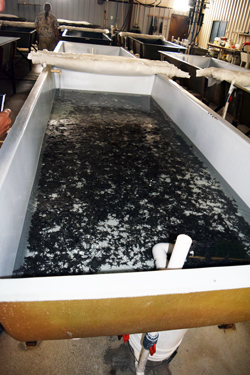
Hi Don
This is Anne from Blue Lobster Farms.
Where you apply to explore the whole website :https://www.bluelobsterfarms.org/
there is some explanation there of that difficult time.
The CDC was bent on closing us down because they said that salmonella was endemic to the species. We were very concerned and voluntarily shut down until the problem was solved, They did not care about the people, the jobs, the animals, the environment nor were they interesting in looking for solutions in being a partner.
We are not part of the food industry. Basically washing hands before and after any interactions with pets especially aquatic pets solves the problems. Partnership for Food Safety Educations http://www.fightbac.org/ has done more than CDC ever did to educate children and the public (they have also done a series of safety with pets).
The Counties both Fresno and Madera and University of CA at Davis researchers and professors whom we worked with for years, came to our aid. We were able to get rid of the contamination and prove through subsequent tests through the disbelieving CD. Local labs also multiple times a year that our frogs not longer had any salmonella. We continue to test as part of our routine now and have a strict hand washing policy no longer giving school tours or allow the public in to keep our facility safe from contamination. It is vitally important for the industry to know that solutions are possible.
We were never vindicated online they trashed our name or long and stellar reputation…. of course because how can a small farm really defend itself….we concentrated on growing healthy safe animals… that was the best we could do for our future and for the society at large